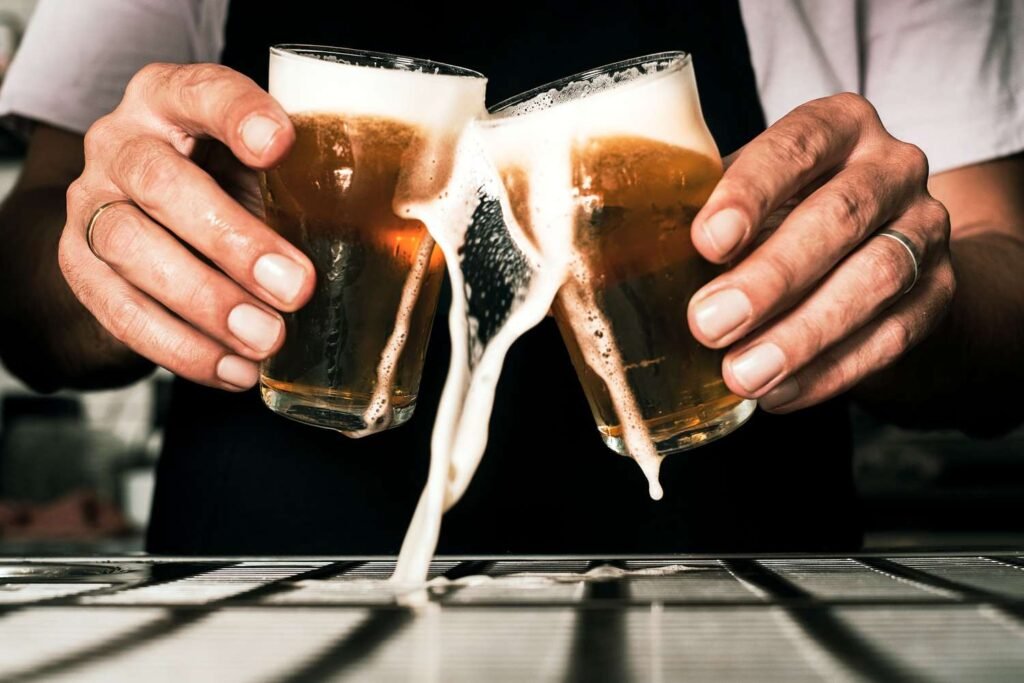The art of pouring the perfect pint of beer goes beyond just filling up a glass. The foam, or head, that sits on top of a freshly poured beer is not just for show; it plays a crucial role in enhancing the overall drinking experience.
According to experts from Carlsberg and Bieres Calvinus, a well-formed foam cap on a beer helps to seal in the aromas, preserve carbonation, and even shape the taste of the beer. The foam traps volatile aromatics, which are released when the bubbles burst, enhancing the aroma and mouthfeel of the beer. Additionally, the foam acts as a barrier to oxidation, keeping the beer fresher for longer.
The science behind the beer head reveals that the appearance of the foam can provide insights into the quality of the beer. Tight and uniform microbubbles indicate a well-brewed beer with good proteins and balanced carbonation, while large bubbles suggest under-carbonation. The duration of the foam on top of the beer also reflects the care taken in the brewing process, with longer-lasting foam indicating a more meticulous carbonation process.
However, not all beers will have a thick and creamy foam head. Factors such as alcohol content, cleanliness of the glass, and pouring technique can impact the formation and stability of the foam. Beers with higher alcohol content tend to have less foam, while contaminants like fats, detergents, or even lipstick residue can affect the stability of the beer head.
To enjoy the full flavor of a beer, it is recommended to drink it while the foam is still intact. The foam acts as a cover, trapping certain aromas and carbon dioxide within the glass. This not only enhances the taste of the beer but also helps maintain its carbonation levels for a longer period. Additionally, a good foam head can prevent spills and serve as an indicator of the beer’s freshness.
Ultimately, the next time you pour yourself a beer, pay attention to the foam on top. It’s not just a visual cue but a key component that contributes to the overall enjoyment of the beer-drinking experience. Cheers to the perfect pour! Hefeweizen, a traditional German wheat beer, is known for its unique flavor profile and hazy appearance. One of the key challenges when it comes to enjoying a Hefeweizen is achieving the perfect pour. The perfect pour not only enhances the visual appeal of the beer but also plays a crucial role in releasing the beer’s aromas and flavors.
According to beer experts like Zollo, achieving the perfect pour for a Hefeweizen involves a series of steps. Firstly, it is essential to rinse the glass before pouring the beer to ensure that there are no residual contaminants that could affect the flavor. Once the glass is rinsed, the beer should be poured at a 45-degree angle to create a smooth flow and prevent excessive foam formation. It is important not to pour the beer all at once but to leave a small amount in the bottle or can.
To further enhance the beer’s flavor and appearance, Zollo suggests swirling the remaining beer in the bottle to loosen any yeast sediment that may have settled at the bottom. This yeast sediment is characteristic of Hefeweizens and adds to the beer’s cloudy appearance and unique taste. Once the yeast is loosened, the remaining beer can be poured into the glass, creating the perfect wheat beer head.
While the process of pouring a Hefeweizen may seem intricate, beer enthusiast Josas believes that it is a combination of technique and artistry. Every detail, from the angle of the pour to the amount of foam, can impact the overall drinking experience. For those who appreciate the nuances of beer drinking, mastering the art of the perfect pour is a rewarding endeavor.
In conclusion, achieving the perfect pour for a Hefeweizen is a process that requires attention to detail and practice. By following the steps outlined by experts like Zollo and embracing the artistry of beer pouring, beer enthusiasts can elevate their Hefeweizen drinking experience and fully appreciate the rich flavors and aromas of this classic wheat beer. Cheers to the perfect pour!


